During World War I, recruitment marches or snowball marches to
Sydney were a feature of volunteer recruiting drives for the Australian Imperial Force in rural New South Wales, Australia. Between October 1915 and February 1916, nine marches were held starting from various points in the state; the most notable was the first march from Gilgandra, known as the Cooee march. There was also a similar march in south-eastern Queensland. In 1918, in an effort to promote recruitment, another march was staged, but this was less spontaneous and the marchers in fact traveled by train.

The Coo-ee march leaves Gilgandra
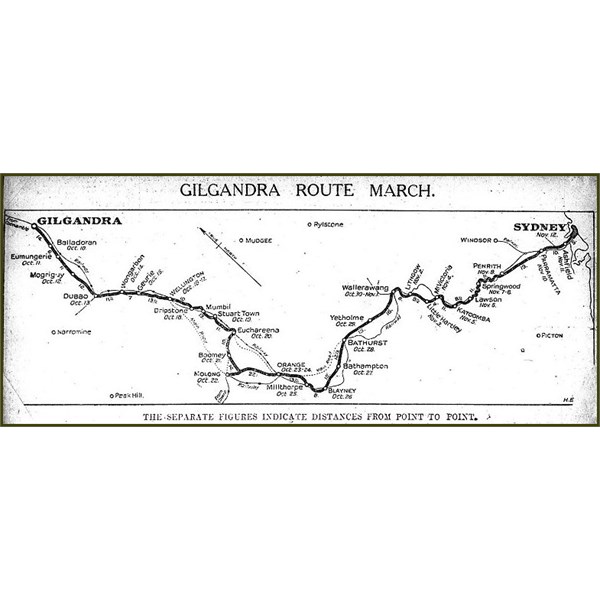
The Route , Gilgandra to Sydney
The marches were called "snowball marches" in the hope that like a snowball rolling down a
hill will pick up more snow, gaining more mass and surface area, and picking up even more snow as it rolls along, the marchers would also collect more marchers as they progressed to the recruiting depot.
The Australian Imperial Force was formed promptly on the declaration of World War I as a volunteer force; many men signed up immediately. From mid-June 1915 there was a substantial increase in recruitment, as state-based Parliamentary recruiting committees were formed and became active in towns, boroughs and shires. In June 1915 the Minister for Defense set recruitment goals at 5,300 men per month in order to maintain the forces fighting at Gallipoli.
This target was exceeded in Victoria when 21,698 men enlisted in that month, the largest number from any state during the war. The campaign in New South Wales by contrast was disappointing for state leaders — especially so in light of interstate rivalry between the two neighbors. It was suggested by the Premier of New South Wales, William Holman, that one of the reasons New South Wales was not meeting the targets was because the military authorities were not ready to accept the men at the time they offered to enlist and told them to come back later.
In response to these embarrassing recruitment shortfalls, some New South Wales residents launched a series of 'snowball' recruiting marches, which were intended to encourage men to enlist through the marchers' example. The first march was a locally based initiative led by the captain of the local Rifle Club in October 1915; eight other marches were known to have taken place over the next four months. Military authorities were initially ambivalent about the marches; they were not certain whether or not the men should march with rifles, when their pay would start, and who would clothe or feed them. Along the route however, local communities fed and housed the men, and the marches gained tremendous publicity. About 1,500 men marched in total, and they are credited by some sources with persuading anywhere from two to three times that number to enlist as a result

Kangaroo March near Wallendbeen, NSW

Patriotic young women and recruiters at Narrabri in December 1915, prior to the start of the Wallaby March from the North West to Newcastle
Twenty six men left Gilgandra on 10 October 1915 on the 'Cooee March', led by the Captain of the local rifle club, William Thomas Hitchen. At each town on the route the marchers shouted "cooee" to attract recruits and held recruitment meetings. By the time they reached
Sydney just over one month later on 12 November, the numbers had swelled to 263 recruits, marching a total of 320
miles and being welcomed by large crowds along the way.
During the march, the Cooees were issued about 50 dungarees in Dubbo, Army greatcoats in
Orange and some additional dungarees in
Lithgow.
Men marched from the south coast: Nowra, Bomaderry, Meroo, Berry,
Gerringong,
Kiama, Jamberoo, Albion Park, Dapto, Unanderra, Port Kembla,
Wollongong, Balgownie, Corrimal, Woonona, Bulli, Thirroul, Coledale,
Scarborough,
Stanwell Park, Helensburgh, Heathcote, Sutherland, Hurstville, Kogarah, Rockdale, arriving at The Domain,
Sydney. The contingent included men from Jervis Bay, and Kangaroo Valley even though these towns were not on the route. The Waratahs entered
camp at Liverpool on 17 December 1915.
Eighty eight potential soldiers left Wagga Wagga on 1 December 1915. They marched via Harefield,
Junee, Illabo, Bethungra, Cootamundra and Wallendbeen. At Wallendbeen on 9 December,
the Governor-General addressed the marchers. After Wallendbeen, they marched via Nubba to Murrumburrah and the next day they were at Harden. They then marched through Galong, Binalong and Bowning to Yass. From Wagga Wagga to Yass was a total of 132
miles, the march travelled at an average of 8.8
miles per day. As with other marches, the men were fed and feted by the local
population; at Murrumburrah, for instance, donations included 114 puddings and 9 sheep to be baked gratis by the local bakers, 200 loaves of bread, 850 potatoes and 30 dozen eggs. They marched to Campbelltown via
Goulburn. The Kangaroo recruits travelled from Campbelltown into
Sydney by train arriving on 7 January 1916 with somewhere between 210 and 230 recruits. It had been decided that this recruitment drive would finish at Campbelltown so that a country contingent could be created. There were reports of rowdy and drunken behaviour along the route by the marchers. The best known recruit from this march was
John Ryan who won the Victoria Cross.
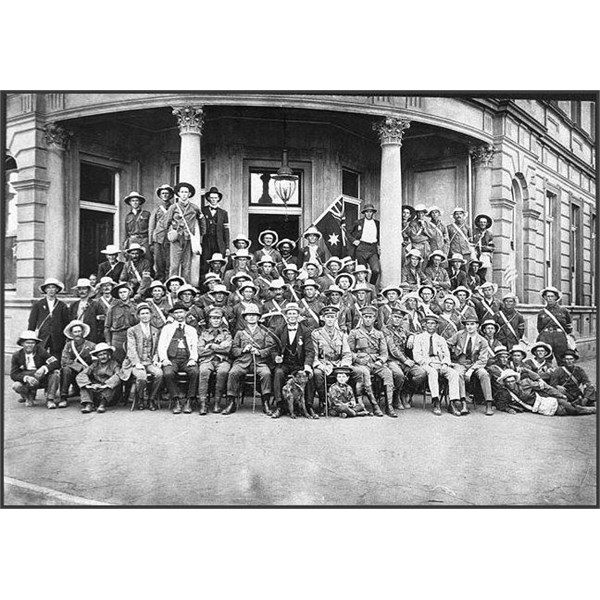
The Boomerangs at Forbes
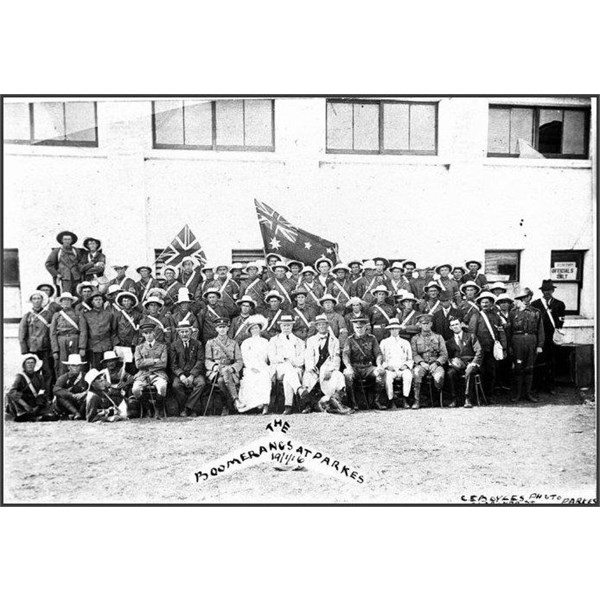
The Boomerangs at the Parkes showground on 19 January 1916
Following the successes of the 'Cooee' march in December 1915, 12 men set out from
Delegate on 6 January 1916 to march the 220
miles to the nearest AIF Training Depot in
Goulburn (currently the site of
Goulburn High School). Marching under the 'Men from
Snowy River' banner (now housed in the Western Front gallery at the Australian War Memorial), the recruitment march passed through the major regional centres of the Monaro, with civil receptions at
Bombala,
Cooma, Queanbeyan, Bungendore and
Goulburn.
The Men from
Snowy River recruitment march arrived in
Goulburn on 28 January 1916 144 men strong. Despite the massive media attention the recruitment march received in the local press, the end result of 144 recruits was disappointing to recruiting staff who had envisaged at least 200 men .
One recruit who did join the march was Ernest Albert Corey, a blacksmith from
Nimmitabel. Corey later served with the 55th battalion as a stretcher bearer, and is recognised as the only soldier in the British Empire to be awarded the Military Medal four times.
The majority of recruits who enlisted during the march later formed the 4th reinforcements of the 55th Battalion, AIF, all of which saw service on the Western front. Of the 144 men that enlisted in the march, 39 were later to be killed in action and 75 became casualties.
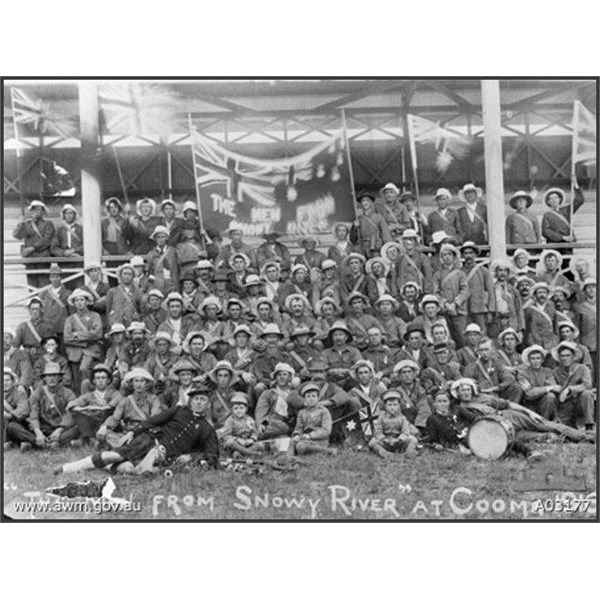
'Men from Snowy River' at Cooma

Hitchen's Coo-ee's at Springwood
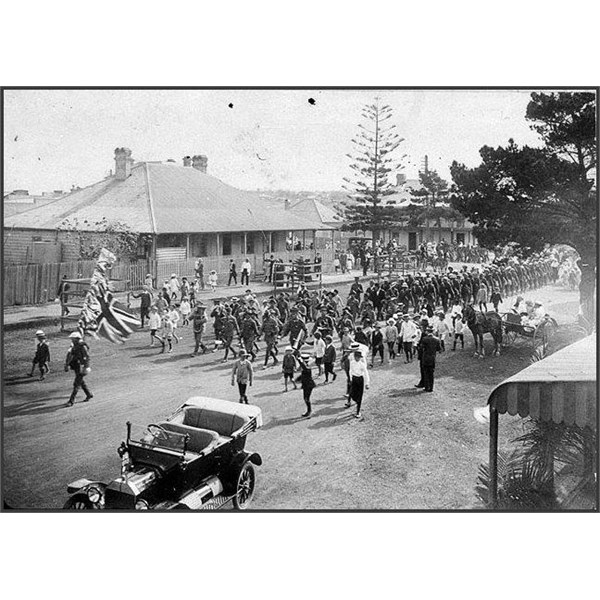
Arrival of ''North Coasters'' recruiting march in Port Macquarie
The Men from
Snowy River recruitment march was relived during the Second World War when men retraced the original path of the 'Snowies', albeit diverting to
Canberra. Both recruitment marches were commemorated by a reenactment of the march and a civil reception at the hall at
Delegate in January 2006, on the 90th anniversary of the original Men from
Snowy River march.
Twenty three men set out in January 1916 from Tooraweenah, New South Wales on a march to
Bathurst to recruit men for service in World War I. Men were recruited from Coolah,
Mendooran and
Dunedoo, Binnaway, Merrygoen and Tucklan. En route, the Kookaburras are remembered for sleeping on the floor of the
Capertee school. There is a veteran's
plaque on the Tooraweenah village common.
Seventy one men left
Parkes by train on 19 January 1916. They marched from Daroobalgie to Donaghey’s
Hill, and then on to
Forbes, Yamma Station, Eugowra, Gooloogong, Canowindra, Billimari, Cowra,
Woodstock,
Lyndhurst, Carcoar,
Blayney, Newbridge (to Georges Plains by train) and
Perthville. They arrived in
Bathurst with 202 recruits on 5 February 1916 at the same time as the Kookaburras from Tooraweenah and were given a combined reception. Each marcher was presented with a medallion in the shape of a boomerang, engraved with their name and town and the words "Come Back".
Twenty eight men left
Warwick, Queensland on 16 November 1915. The 'Dungaree march' in south-east Queensland made its way through
Allora, Clifton, Greenmount, Cambooya,
Toowoomba, Helidon, Gatton, Laidley, Rosewood,
Ipswich and Oxley. The 160
miles march ended in
Brisbane with 125 recruits.
On the Light Horse memorial at Cowra, a
plaque commemorates the re-enactment of the 1916 Boomerang march held in February 1999
.